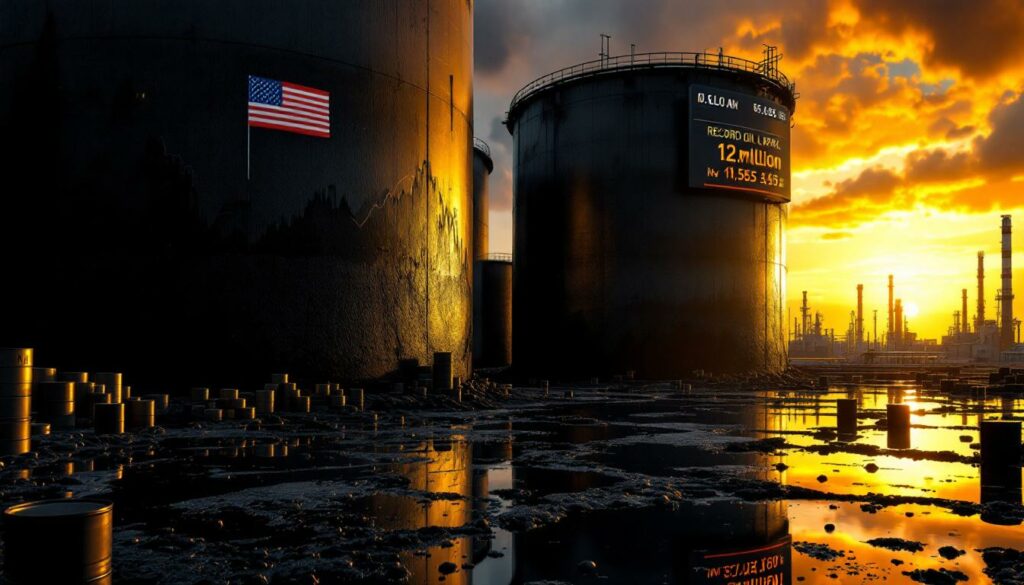What Caused the Biggest Crude Inventory Build of the Decade?
The oil market was rocked recently by what analysts are calling the most significant crude inventory build in over a decade. This massive and unexpected surge in U.S. oil stockpiles sent shockwaves through energy markets, putting tremendous pressure on oil bulls and raising serious questions about underlying market fundamentals. The sudden build caught most analysts off guard, revealing potential weaknesses in global oil demand that many market participants had previously overlooked.
The inventory surge comes at a particularly surprising time, as summer driving season typically leads to inventory drawdowns rather than builds. This counter-seasonal movement has intensified concerns about structural imbalances in the oil market that may persist beyond temporary factors.
How Large Was the Recent Crude Inventory Build?
Record-Breaking Numbers
The U.S. Energy Information Administration (EIA) reported a staggering crude oil inventory increase of 12.3 million barrels for a single week—the largest weekly build in more than ten years. This massive surge dramatically exceeded analyst predictions, which had anticipated a modest increase of approximately 1.3 million barrels according to consensus estimates compiled by Bloomberg.
"This inventory build caught the entire market off guard," noted a Goldman Sachs research note published immediately after the EIA release. "The magnitude suggests deeper structural issues beyond seasonal factors."
Historical Context
When placed in historical perspective, this inventory build becomes even more remarkable:
| Period | Average Weekly Build | Recent Build | Difference |
|---|---|---|---|
| 5-Year Average | 0.5-1.5 million barrels | 12.3 million barrels | +10.8 million barrels |
| Previous Decade High | 8.2 million barrels (2016) | 12.3 million barrels | +4.1 million barrels |
| Typical Seasonal Pattern | Drawdowns expected | Major build observed | Contrary to seasonal norm |
The build was particularly notable at Cushing, Oklahoma—the delivery point for WTI crude futures—where inventories surged to 42 million barrels, representing approximately 80% of working capacity. This level of storage utilization at the nation's primary crude oil hub hasn't been seen since the height of pandemic-related supply gluts.
What Factors Contributed to This Massive Inventory Build?
Surging U.S. Production
Domestic oil production has reached unprecedented levels, with US oil production decline consistently exceeding 13.2 million barrels per day according to the latest EIA data. This production boom represents a significant factor in the inventory buildup, as domestic supply continues to outpace both refinery capacity and export capabilities.
The Permian Basin alone is producing 5.8 million barrels daily—a record high despite recent price declines—according to the Dallas Fed Energy Survey. This remarkable production resilience in the face of lower prices has contributed significantly to the oversupply situation.
"U.S. shale has proven far more resilient to price swings than many anticipated," explains an energy analyst at J.P. Morgan. "Technological improvements and efficiency gains have driven breakeven prices lower, allowing production to remain economical even at current price levels."
Refinery Maintenance Issues
Several major U.S. refineries have experienced:
- Scheduled maintenance shutdowns affecting over 1 million bpd of capacity
- Unexpected operational disruptions at three major Gulf Coast facilities
- Reduced utilization rates (dropping to 84.6% versus the seasonal average of 92%)
These refinery challenges have significantly decreased crude processing capacity, leading to accumulation in storage facilities rather than conversion to refined products. The timing of these maintenance issues—coming during what should be peak gasoline production season—has exacerbated the inventory build.
Import/Export Imbalance
Recent weeks have witnessed a perfect storm of factors affecting the import/export balance:
- Increased crude imports from Canada reaching 4.5 million bpd (a five-year high)
- Temporary export constraints due to Hurricane Beryl affecting Gulf Coast shipping
- Port congestion in Houston and Corpus Christi delaying approximately 2.3 million barrels of exports
This imbalance between rising imports and constrained exports has contributed substantially to the inventory buildup. Canadian heavy oil producers, in particular, have been pushing record volumes to U.S. refineries, many of which were operating at reduced capacity.
How Did Markets React to the Inventory Build?
Immediate Price Response
The market reaction was swift and decisive following the EIA's report:
- WTI crude prices dropped over 4.2% in the immediate aftermath, settling at $65.12 per barrel
- Brent crude experienced similar declines, falling below $70 per barrel for the first time in months
- The WTI-Brent spread widened significantly to over $5.50 per barrel, reflecting the localized nature of the U.S. oversupply
This price movement represented one of the sharpest single-day declines in 2025, erasing several weeks of gains in mere hours. The psychological impact of breaking below key support levels amplified the selling pressure.
Trading Volume Surge
The inventory announcement triggered exceptional trading activity across energy markets:
- Trading volumes more than doubled typical daily averages on both WTI and Brent contracts
- Options market activity surged, particularly in put options, with volume up 200% according to CME Group data
- Volatility indexes for oil markets spiked to 45.6—a six-month high according to CBOE data
Algorithmic trading systems appeared to amplify the initial price movements, with momentum-based models triggering cascading sell orders as key technical levels were breached. This technological factor explains some of the oversized market reaction relative to fundamental changes.
Trader Positioning Shifts
The inventory build prompted significant repositioning among market participants:
- Bullish speculative positions were rapidly unwound, with CFTC data showing a 15% reduction in net long positions
- Commercial hedgers increased their protective positions, with producers locking in prices for future production
- Investment funds shifted toward bearish strategies, with short interest in major energy ETFs rising dramatically
"The market was heavily positioned for summer driving season strength," noted a commodities strategist at Citi. "This inventory report forced a rapid unwinding of those positions, magnifying price moves beyond what fundamentals might justify."
What Does This Mean for Oil Market Fundamentals?
Supply-Demand Imbalance Signals
The massive inventory build highlights several concerning fundamental factors:
- Potential overestimation of global demand growth, which the IEA has now revised downward to 1.1 million bpd for 2025
- Underestimation of non-OPEC supply resilience, particularly from U.S. shale, Brazil, and Guyana
- Questions about the effectiveness of OPEC+ production policies in balancing the market
The IEA's latest Oil Market Report indicates a global surplus of 1.8 million barrels per day for Q3 2025—a significant revision from previous estimates that had suggested a much tighter market. This surplus appears to be materializing faster than many had anticipated.
Storage Capacity Considerations
With inventories rising rapidly, attention turns to storage infrastructure:
- Current U.S. storage utilization has increased to approximately 67% (versus the five-year average of 52%)
- Cushing, Oklahoma hub storage has risen above 42 million barrels, approaching levels that historically have created logistical constraints
- Commercial storage rates have begun to increase in anticipation of further builds, with monthly leasing costs up nearly 20%
While far from the critical levels seen during the 2020 pandemic (when Cushing reached 95% capacity), the rapid pace of inventory accumulation raises questions about how long the build can continue before creating physical constraints or more severe price pressures.
Seasonal Pattern Disruption
This inventory build contradicts typical seasonal patterns:
- Summer driving season normally reduces crude inventories as refineries maximize gasoline production
- Refinery utilization typically peaks during this period to meet seasonal demand
- U.S. gasoline demand is down 3.1% year-over-year, suggesting consumer behavior changes beyond seasonal factors
"The unusual build suggests deeper structural issues that can't be explained by refinery maintenance alone," explains an energy economist at the EIA. "We're seeing potential signs of demand destruction at current price levels, combined with resilient supply growth."
How Might OPEC+ Respond to This Development?
Production Cut Extension Possibilities
The inventory surge increases pressure on OPEC+ to take more aggressive action:
- Potentially extend existing production cuts beyond their scheduled expiration date
- Consider deeper cuts to address the growing supply imbalance (currently at 1.8 million bpd according to the IEA)
- Reevaluate the planned gradual return of production capacity that was scheduled to begin later this year
The group's next meeting, originally planned as a routine monitoring session, may now transform into a more substantive policy discussion. Several OPEC members have already indicated willingness to support extended cuts if market conditions warrant.
Saudi Arabia's Strategic Options
As the group's largest producer, Saudi Arabia faces difficult choices:
- Maintain current production levels despite price pressure, risking budget shortfalls with prices below their fiscal breakeven of $80 per barrel
- Shoulder additional voluntary cuts to stabilize the market, as they've done in previous market downturns
- Balance market share concerns against price support objectives, particularly as U.S. producers continue gaining global market share
"We are committed to maintaining our 12.3 million barrels per day capacity," stated Saudi Energy Minister Prince Abdulaziz bin Salman in October 2024, indicating the kingdom's continued focus on long-term production potential despite current market challenges.
Compliance Challenges
The inventory build may exacerbate existing OPEC+ compliance issues:
- Some members already producing above agreed quotas (notably Iraq at 65% compliance and Kazakhstan at similar levels)
- Economic pressures making production discipline more difficult for financially strained members
- Questions about the coalition's long-term cohesion as market share concerns intensify
The July quota adherence shows a striking disparity—Saudi Arabia at 112% compliance while several other major producers remain well below their commitments. This compliance gap creates internal tensions that could complicate any agreement on further production restraint.
What Are the Implications for Energy Investors?
Oil Producer Stock Performance
Energy stocks have responded negatively to the inventory news:
- Major integrated oil companies experienced share price declines of 2-5%
- Independent producers with higher breakeven costs saw steeper drops, with some stocks falling over 8%
- Oilfield service companies faced renewed investor concerns, with the OSX index dropping 6.3% in two days
The XLE Energy ETF, which tracks the sector broadly, fell 5.3% in the two days following the inventory report—significantly underperforming the broader market. Companies with higher debt levels or breakeven prices above $60 per barrel experienced the most severe selling pressure.
Investment Strategy Adjustments
The inventory build is prompting strategy reconsiderations:
- Increased focus on companies with lower production costs (Exxon's $35/bbl breakeven versus smaller independents at $55+)
- Greater emphasis on balance sheet strength and dividend sustainability as potential downside protection
- Renewed interest in companies with diversified energy portfolios, including both traditional and renewable assets
"In this environment, we're prioritizing companies with strong free cash flow generation even at $60 oil," noted a portfolio manager at a major asset management firm. "The days of chasing pure production growth regardless of economics are long gone."
Risk Management Importance
The volatility highlights the importance of risk management:
- Options strategies becoming more prevalent among energy investors to hedge downside risks
- Increased hedging activity by producers, with Permian basin operators now hedging 45% of their 2026 output at $70+
- Portfolio diversification to mitigate energy sector exposure, with many institutional investors reducing overall sector weightings
These risk management approaches reflect a growing recognition that oil price crash analysis may persist longer than previously anticipated, requiring more sophisticated approaches to protecting capital.
How Could This Affect Global Economic Outlook?
Inflation Implications
Lower oil prices resulting from the inventory build could have significant macroeconomic effects:
- Help moderate inflationary pressures in major economies, with models suggesting a 10% oil price drop translates to approximately 0.4% lower U.S. CPI
- Reduce input costs for manufacturing and transportation sectors, potentially improving corporate margins
- Potentially influence central bank monetary policy decisions, creating more room for accommodative policies
For economies still battling persistent inflation, the oil price decline represents a welcome development that could reduce pressure for additional interest rate hikes.
Consumer Benefits
Declining oil prices may benefit consumers through:
- Lower gasoline prices at the pump, which have already fallen to $3.18 per gallon nationally (AAA data)
- Reduced heating and energy costs for households, with potential savings of $15 monthly for the average family
- Potentially increased discretionary spending in other sectors as energy costs decline
These consumer benefits could provide a modest economic stimulus effect, particularly for lower-income households that spend a higher percentage of their income on energy costs.
Producing Nation Challenges
For oil-dependent economies, the inventory build creates significant challenges:
- Budget pressures for nations with high fiscal breakeven prices, such as Nigeria ($75/bbl) and several other OPEC members
- Potential currency weaknesses in oil-exporting countries as petroleum revenues decline
- Increased economic diversification urgency, accelerating existing plans to reduce oil dependence
"Oil-dependent economies face fiscal stress below $80 per barrel," warned an IMF spokesperson in their latest Fiscal Monitor. This pressure is already visible in several countries, with Nigeria seeking a 25% higher OPEC+ quota to compensate for lower prices.
What's the Outlook for Oil Markets Following This Build?
Near-Term Price Projections
Market analysts have adjusted their near-term outlooks in response to the inventory build:
- Downward revisions to Q3 price forecasts by 5-10%, with Goldman Sachs cutting their Brent target to $70
- Increased probability of prices testing support levels below $65 for WTI in the coming weeks
- Wider expected trading ranges reflecting heightened uncertainty about market fundamentals
The consensus view appears to be shifting toward a more bearish outlook for the remainder of 2025, with most analysts no longer expecting oil price rally to return to the $80+ levels seen earlier in the year.
Inventory Normalization Timeline
Estimates for returning to balanced inventory levels vary considerably:
- Optimistic scenarios suggest 2-3 months of adjustment, assuming refinery utilization returns to seasonal norms
- More conservative projections indicate 4-6 months may be required to work through the excess inventory
- Much depends on production discipline and demand recovery, particularly as we approach the fall refinery maintenance season
The path to inventory normalization will likely require a combination of production restraint (both from OPEC+ and potentially U.S. producers responding to price signals) and seasonal demand increases as refinery operations return to normal.
Key Monitoring Indicators
Market participants should closely watch several indicators in the coming weeks:
- Weekly EIA inventory reports for trend confirmation, particularly focusing on Cushing storage levels
- Refinery utilization rates as maintenance season concludes, with attention to how quickly capacity returns
- OPEC+ communication and compliance data, especially ahead of their upcoming technical committee meetings
These indicators will provide early signals about whether the inventory build represents a temporary anomaly or a more persistent structural imbalance requiring significant market adjustments. Furthermore, analysts will closely monitor the trade war impact on oil markets as geopolitical tensions continue to influence prices.
FAQ: Understanding the Crude Inventory Build
Why did this inventory build happen during driving season?
The summer driving season typically reduces crude inventories as refineries process more oil into gasoline. However, this year's build occurred due to a combination of refinery maintenance issues, continued high domestic production, and weaker-than-expected gasoline demand growth. U.S. gasoline demand is down 3.1% year-over-year, suggesting potential changes in consumer behavior beyond seasonal factors.
How does this inventory build compare to the 2020 pandemic surge?
While significant, this inventory build differs fundamentally from the 2020 pandemic-related surge. The current build stems primarily from supply-side factors and refinery issues rather than the catastrophic demand collapse witnessed during pandemic lockdowns. In 2020, U.S. storage approached capacity limits (with Cushing reaching 95% full), whereas current utilization remains at more manageable levels (67% nationally). The scale is also different—the pandemic caused a 96 million barrel build over several months, while the current situation represents a 12.3 million barrel increase in a single week.
Could this inventory build signal a coming recession?
While the inventory build alone doesn't necessarily indicate an imminent recession, it does reflect potential demand weakness that warrants monitoring alongside other economic indicators. Energy demand has historically correlated with broader economic activity. The 3.1% year-over-year decline in gasoline consumption despite relatively stable pricing suggests consumers may be adjusting behavior in response to broader economic concerns. However, most economists view this as one data point rather than a definitive recession signal.
How might this affect gasoline prices?
Want to Catch the Next Major Mineral Discovery Before the Market?
Discovery Alert's proprietary Discovery IQ model provides instant notifications on significant ASX mineral discoveries, empowering investors to identify actionable opportunities ahead of the broader market. Explore why historic discoveries can generate substantial returns by visiting the Discovery Alert discoveries page and begin your 30-day free trial today.




